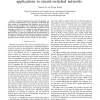Free Online Productivity Tools
i2Speak
i2Symbol
i2OCR
iTex2Img
iWeb2Print
iWeb2Shot
i2Type
iPdf2Split
iPdf2Merge
i2Bopomofo
i2Arabic
i2Style
i2Image
i2PDF
iLatex2Rtf
Sci2ools
INFOCOM
2003
IEEE
2003
IEEE
Nash equilibria of a generic networking game with applications to circuit-switched networks
— A generic mechanism for end-user transmission rate control into a differentiated services Internet is formulated and basic results of corresponding Nash equilibria are proved. We consider specific examples of the mechanism including additive increase and multiplicative decrease inspired by present day TCP congestion control. For the example of users sharing access to a bandwidth resource via resizable provisioned label-switched paths (MPLS), we study the equilibria and the performance of the generic mechanism and give analytical results on convergence to equilibria. The fairness of the resulting equilibria when user demands exceed available network resources is also studied.
Related Content
| Added | 04 Jul 2010 |
| Updated | 04 Jul 2010 |
| Type | Conference |
| Year | 2003 |
| Where | INFOCOM |
| Authors | Youngmi Jin, George Kesidis |
Comments (0)

